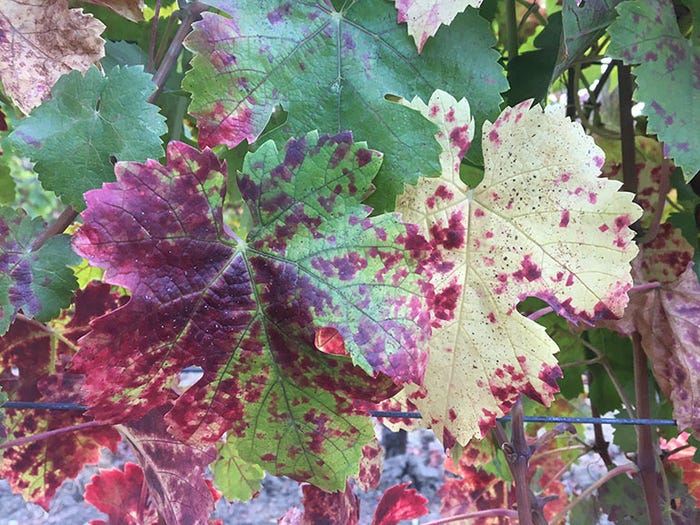
While the world deals with one type of virus, grape growers in California have a few viral problems specific to their industry.
By definition, a virus is an ultramicroscopic, metabolically inert, infectious agent that replicates, grows, and multiplies within the cells of living hosts — to wit, grapevine red blotch and leafroll.
Marc Fuchs at Cornell University College of Agriculture, a 30-year veteran in the field of plant pathology, is a leading researcher of grapevine virus diseases who suggests that West Coast growers remain vigilant.
“If you’re dealing with a vineyard virus, you should see the first disease symptoms in June or July, becoming more pronounced around the start of picking time in September or October,” he said.
Somewhere along the line, says Fuchs, growers have to make up their mind how they are going to handle vineyards infected with leafroll or red blotch.
“They don’t kill the vine, but they do diminish the product and make its quality sub-optimal because fruits don’t ripen and flavors are way off,” he said. “If you’re a wine grape grower, there are huge repercussions on the quality of wine you can produce.”
Disease hot spots
Asked if there were any disease hot spots in California, he said, “Right now, it’s pretty widespread, more or less everywhere throughout the country. Based on conversations with my California colleagues, there is no particular area that looks worse than others. If the virus is in the vineyard, regardless of whether its Napa, Sonoma, or Monterey, it’s a problem.”
And management options are limited once a vine is infected.
“There’s no cure once a virus has infected a vine. It remains infected until it’s removed,” he said. “Growers need to be very vigilant in monitoring how fast newly-established vineyards with clean vines become infected because the infection rate can be kept at bay.”
He cites a parallel with the COVID-19 coronavirus and its progress curve. “It goes up very slowly until suddenly you have an explosion in the curve. If there is an infection in the vineyard, this is what growers are trying to avoid.”

So, is he expecting any such explosion in the California grape virus curve this year? “A lot depends on the weather,” he replies. “Viruses need optimal conditions to thrive and if the plant is stressed, the virus tries to overcome its defense mechanisms. If this spring is cool and wet, the virus basically turns things into an arms race and diseases are more pronounced. I anticipate if the spring is nice, warm, and not too humid, there shouldn’t be a spike in either red blotch or leafroll diseases in 2020.”
Spotted lanternfly
Aside from the potential, read “eventual," establishment of the spotted lanternfly’s arrival along the Pacific coast, are researchers looking at any potential new threats to the industry? “I don’t foresee any in the immediate future,” he replies.
“However, that being said, as diagnostic technologies and methodologies become more robust, we are discovering new grape viruses. In California, some wild grapes are growing in ditches and wooded, riparian areas, that carry viruses that are, so far, restricted from wine grapes. Currently, we don’t know of their occurrence in commercial vineyards, but it’s just a matter of time for those viruses to move from wild grapes to commercial and this could be a concern for the long run. For the moment, I don’t see any major concern that the California grape growing community should put on their radar screen.”
Fuchs expressed further optimism, “Based on the increased diligence the industry had undertaken in the management of red blotch and leafroll, the positive actions that growers have already taken, I anticipate those two diseases will become less prevalent in their vineyards.”
Earlier this year, at the Unified Wine & Grape Symposium, he outlined possible mitigation options that included crop load management and selective removal of diseased parcels and vines. “For red blotch, if less than 30% of the parcel is diseased, remove those vines. Remove the entire parcel if more than 30% is diseased. Insecticide applications aren’t effective at that point.
“For leafroll, if less than 25% of the parcel is infected, remove the diseased vines and apply pesticides. More than 25% — remove the entire parcel.”
For more news on pests, disease management and other issues affecting vineyards, subscribe to the bi-monthly newsletter The Grape Line.
About the Author(s)
You May Also Like




